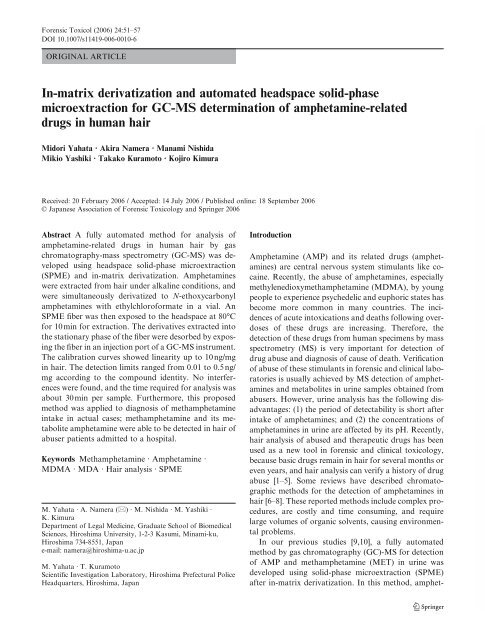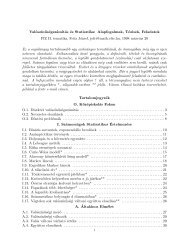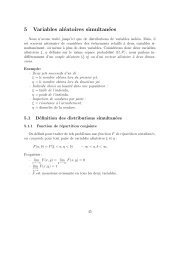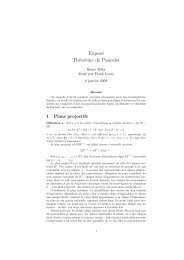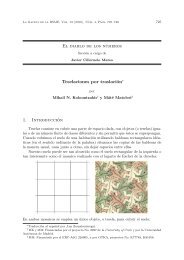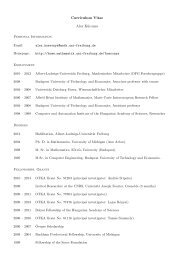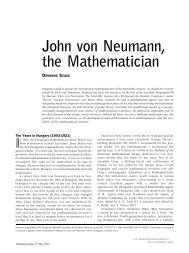In-matrix derivatization and automated headspace solid-phase ...
In-matrix derivatization and automated headspace solid-phase ...
In-matrix derivatization and automated headspace solid-phase ...
Create successful ePaper yourself
Turn your PDF publications into a flip-book with our unique Google optimized e-Paper software.
Forensic Toxicol (2006) 24:51–57<br />
DOI 10.1007/s11419-006-0010-6<br />
ORIGINAL ARTICLE<br />
<strong>In</strong>-<strong>matrix</strong> <strong>derivatization</strong> <strong>and</strong> <strong>automated</strong> <strong>headspace</strong> <strong>solid</strong>-<strong>phase</strong><br />
microextraction for GC-MS determination of amphetamine-related<br />
drugs in human hair<br />
Midori Yahata · Akira Namera · Manami Nishida<br />
Mikio Yashiki · Takako Kuramoto · Kojiro Kimura<br />
Received: 20 February 2006 / Accepted: 14 July 2006 / Published online: 18 September 2006<br />
© Japanese Association of Forensic Toxicology <strong>and</strong> Springer 2006<br />
Abstract A fully <strong>automated</strong> method for analysis of<br />
amphetamine-related drugs in human hair by gas<br />
chromatography-mass spectrometry (GC-MS) was developed<br />
using <strong>headspace</strong> <strong>solid</strong>-<strong>phase</strong> microextraction<br />
(SPME) <strong>and</strong> in-<strong>matrix</strong> <strong>derivatization</strong>. Amphetamines<br />
were extracted from hair under alkaline conditions, <strong>and</strong><br />
were simultaneously derivatized to N-ethoxycarbonyl<br />
amphetamines with ethylchloroformate in a vial. An<br />
SPME fiber was then exposed to the <strong>headspace</strong> at 80°C<br />
for 10min for extraction. The derivatives extracted into<br />
the stationary <strong>phase</strong> of the fiber were desorbed by exposing<br />
the fiber in an injection port of a GC-MS instrument.<br />
The calibration curves showed linearity up to 10 ng/mg<br />
in hair. The detection limits ranged from 0.01 to 0.5 ng/<br />
mg according to the compound identity. No interferences<br />
were found, <strong>and</strong> the time required for analysis was<br />
about 30 min per sample. Furthermore, this proposed<br />
method was applied to diagnosis of methamphetamine<br />
intake in actual cases; methamphetamine <strong>and</strong> its metabolite<br />
amphetamine were able to be detected in hair of<br />
abuser patients admitted to a hospital.<br />
Keywords Methamphetamine · Amphetamine ·<br />
MDMA · MDA · Hair analysis · SPME<br />
M. Yahata · A. Namera (*) · M. Nishida · M. Yashiki ·<br />
K. Kimura<br />
Department of Legal Medicine, Graduate School of Biomedical<br />
Sciences, Hiroshima University, 1-2-3 Kasumi, Minami-ku,<br />
Hiroshima 734-8551, Japan<br />
e-mail: namera@hiroshima-u.ac.jp<br />
M. Yahata · T. Kuramoto<br />
Scientific <strong>In</strong>vestigation Laboratory, Hiroshima Prefectural Police<br />
Headquarters, Hiroshima, Japan<br />
<strong>In</strong>troduction<br />
Amphetamine (AMP) <strong>and</strong> its related drugs (amphetamines)<br />
are central nervous system stimulants like cocaine.<br />
Recently, the abuse of amphetamines, especially<br />
methylenedioxymethamphetamine (MDMA), by young<br />
people to experience psychedelic <strong>and</strong> euphoric states has<br />
become more common in many countries. The incidences<br />
of acute intoxications <strong>and</strong> deaths following overdoses<br />
of these drugs are increasing. Therefore, the<br />
detection of these drugs from human specimens by mass<br />
spectrometry (MS) is very important for detection of<br />
drug abuse <strong>and</strong> diagnosis of cause of death. Verification<br />
of abuse of these stimulants in forensic <strong>and</strong> clinical laboratories<br />
is usually achieved by MS detection of amphetamines<br />
<strong>and</strong> metabolites in urine samples obtained from<br />
abusers. However, urine analysis has the following disadvantages:<br />
(1) the period of detectability is short after<br />
intake of amphetamines; <strong>and</strong> (2) the concentrations of<br />
amphetamines in urine are affected by its pH. Recently,<br />
hair analysis of abused <strong>and</strong> therapeutic drugs has been<br />
used as a new tool in forensic <strong>and</strong> clinical toxicology,<br />
because basic drugs remain in hair for several months or<br />
even years, <strong>and</strong> hair analysis can verify a history of drug<br />
abuse [1–5]. Some reviews have described chromatographic<br />
methods for the detection of amphetamines in<br />
hair [6–8]. These reported methods include complex procedures,<br />
are costly <strong>and</strong> time consuming, <strong>and</strong> require<br />
large volumes of organic solvents, causing environmental<br />
problems.<br />
<strong>In</strong> our previous studies [9,10], a fully <strong>automated</strong><br />
method by gas chromatography (GC)-MS for detection<br />
of AMP <strong>and</strong> methamphetamine (MET) in urine was<br />
developed using <strong>solid</strong>-<strong>phase</strong> microextraction (SPME)<br />
after in-<strong>matrix</strong> <strong>derivatization</strong>. <strong>In</strong> this method, amphet-<br />
13
52 Forensic Toxicol (2006) 24:51–57<br />
amines were quickly converted to N-ethoxycarbonyl derivatives<br />
using ethylchloroformate in urine <strong>and</strong> then the<br />
derivatives were extracted from the <strong>headspace</strong> by SPME.<br />
<strong>In</strong> the present study, we have extended this line of experiments<br />
to human hair for optimization of the experimental<br />
conditions.<br />
Materials <strong>and</strong> methods<br />
Materials<br />
AMP hydrosulfate <strong>and</strong> pentadeuterated MET (MET-d 5,<br />
internal st<strong>and</strong>ard, IS) hydrochloride were supplied by<br />
Dr. Hara of Fukuoka University (Fukuoka, Japan).<br />
MET hydrochloride was purchased from Dainippon<br />
Pharmaceutical (Osaka, Japan); methylenedioxyamphetamine<br />
(MDA) <strong>and</strong> MDMA were purchased from<br />
Sigma (St. Louis, MO, USA). Other common reagents<br />
<strong>and</strong> solvents used were of the highest quality commercially<br />
available. Stock st<strong>and</strong>ard solutions of amphetamines<br />
(1.0mg/ml) were dissolved in 0.01 M HCl <strong>and</strong><br />
stored at 4°C in a refrigerator.<br />
An SPME autosampler holder <strong>and</strong> a fiber assembly<br />
coated with polydimethylsiloxane (PDMS, 100µm) [11]<br />
were purchased from Supelco (Tokyo, Japan). The fibers<br />
were conditioned in a GC injection port at 250°C for 1 h<br />
prior to use.<br />
GC-MS conditions<br />
The GC-MS instrument used was a GC-17A <strong>and</strong> QP-<br />
5000 (Shimadzu, Kyoto, Japan), equipped with a 30 m ×<br />
0.25 mm (i.d.) fused silica capillary column (Supelco,<br />
PTE-5, film thickness 0.25 µm). The oven temperature<br />
was programmed from 80° (3-min hold) to 220°C at<br />
40°C/min <strong>and</strong> from 220° to 280°C (3-min hold) at 8°C/<br />
min. The temperatures of the injection port <strong>and</strong> interface<br />
were set at 250° <strong>and</strong> 230°C, respectively. Splitless injection<br />
mode was used. Helium was used as a carrier gas at<br />
a flow rate of 0.8 ml/min. Ions used for identification<br />
were m/z 91, 116, <strong>and</strong> 207 for AMP, m/z 91, 102, 130,<br />
<strong>and</strong> 221 for MET, m/z 116, 135, <strong>and</strong> 251 for MDA, <strong>and</strong><br />
m/z 102, 130, 135, <strong>and</strong> 265 for MDMA. Ions used for<br />
quantitation in the selected ion monitoring (SIM) mode<br />
were m/z 116 for AMP <strong>and</strong> MDA, m/z 130 for MET <strong>and</strong><br />
MDMA, <strong>and</strong> m/z 134 for MET-d 5 (IS).<br />
Hair samples<br />
Drug-free hair samples, collected from healthy men who<br />
had not taken drugs, were used as blank hair or that to<br />
be spiked with amphetamines. Hair samples of abusers<br />
13<br />
were cut at the surface of the scalp with their consent.<br />
Drug-free hair <strong>and</strong> abusers’ hair samples collected<br />
from clinical <strong>and</strong> medico-legal cases were kept at 4°C<br />
until analyzed. Each hair was washed with sodium<br />
dodecylsulfate (0.1%, three times), distilled water (three<br />
times), methanol (once), <strong>and</strong> then dried at room temperature.<br />
Each hair was cut into 1-mm lengths prior to<br />
SPME.<br />
A “control hair solution” was used to optimize analytical<br />
conditions. The control hair solution was prepared<br />
with a slight modification of the method described<br />
by Koide et al. [12]. <strong>In</strong> brief, a 0.5-g of hair from healthy<br />
men was dissolved in 50ml of 5M NaOH by heating at<br />
75°C for 1h.<br />
SPME procedure<br />
A washed hair (10mg), NaOH solution (5 M, 1.0 ml),<br />
ethylchloroformate (20 µl), <strong>and</strong> IS (1.0µg/ml, 30 µl) were<br />
placed in a 10-ml vial <strong>and</strong> sealed rapidly with a silicone<br />
septum cap. The vials were placed in a sample tray. The<br />
following procedures (extraction <strong>and</strong> introduction to a<br />
GC-MS instrument) were performed automatically using<br />
Combi PAL (CTC Analytics, Zwingen, Switzerl<strong>and</strong>).<br />
The operator was not required to touch the sample until<br />
the analysis was complete. The vial was rotated at<br />
250 rpm <strong>and</strong> heated at 80°C for 10min to dissolve a hair<br />
sample. The SPME needle was then inserted into the vial<br />
<strong>and</strong> the extraction fiber was exposed at 80°C for 10 min<br />
in the <strong>headspace</strong>. The vial was rotated at 250 rpm during<br />
the SPME extraction. After extraction, the fiber was<br />
pulled back into the needle <strong>and</strong> the needle was then<br />
inserted into the injection port of the GC-MS instrument.<br />
The fiber was exposed in the injection port to<br />
desorb the analytes from the fiber for 3 min.<br />
Results<br />
Optimization of conditions<br />
The dissolution of hair <strong>matrix</strong> was necessary prior to<br />
extraction of amphetamines from hair. Three main<br />
methods were used to dissolve the hair <strong>matrix</strong> with: (1)<br />
strong alkali, (2) strong acid, <strong>and</strong> (3) enzyme hydrolysis.<br />
A fourth method employed a methanol extraction without<br />
dissolution of hair <strong>matrix</strong>. Higher extraction yield<br />
was obtained at pH higher than 10, because of the high<br />
acid dissociation constants of amphetamines (pK a 9.6–<br />
10.1) [13]. When acid or enzyme hydrolysis was used, the<br />
vial had to be opened to adjust the pH of the dissolved<br />
sample before the SPME extraction. The addition of<br />
excess methanol affected the SPME extraction badly.
Forensic Toxicol (2006) 24:51–57 53<br />
Fig. 1 Effects of<br />
ethylchloroformate<br />
concentrations on the yields<br />
of derivatives of amphetamines<br />
using <strong>headspace</strong> <strong>solid</strong><strong>phase</strong><br />
microextraction<br />
(SPME) with in-<strong>matrix</strong><br />
<strong>derivatization</strong>. The<br />
concentration of each drug<br />
was 50 ng/ml in the presence<br />
of 10 mg hair in a vial. AMP,<br />
amphetamine; MET,<br />
methamphetamine; MDA,<br />
methylenedioxyamphetamine;<br />
MDMA, methylenedioxymethamphetamine<br />
Peak Area<br />
800000<br />
700000<br />
600000<br />
500000<br />
400000<br />
300000<br />
200000<br />
100000<br />
The alkaline hydrolysis was advantageous for dissolving<br />
the hair <strong>matrix</strong>, <strong>and</strong> extracting <strong>and</strong> derivatizing amphetamines<br />
in hair in the same vial simultaneously. <strong>In</strong> this<br />
study, therefore, alkaline hydrolysis was adopted to dissolve<br />
hair.<br />
The extraction yield is affected by the amounts of the<br />
organic products formed after alkaline hydrolysis of<br />
hair. To examine such effects, the extraction yields of<br />
amphetamines spiked into the hair solution were tested<br />
as a function of amounts of hair (1, 3, 7, 10, 20, <strong>and</strong><br />
40mg/vial) by heating at 80°C in 0.5 M NaOH solution.<br />
The results showed yields of 90–100% in the presence of<br />
1–10mg of hair in a vial. <strong>In</strong> the presence of more than<br />
20mg of hair, the yields decreased to only 10–60%.<br />
Therefore, 10 mg was adopted as the amount of hair for<br />
each vial.<br />
To minimize the damage to the fiber <strong>and</strong> maximize<br />
the in-<strong>matrix</strong> <strong>derivatization</strong>, the amounts of<br />
ethylchloroformate to be added were optimized. The<br />
amounts of derivatives of amphetamines adsorbed to the<br />
fiber were largest at 20 µl (Fig. 1). Therefore, 20 µl of<br />
ethylchloroformate was adopted as the volume for routine<br />
analysis. The effect of NaOH concentration in hair<br />
solution on the yield of the derivatives was also tested by<br />
heating at 80°C for 20 min. Although the yields increased<br />
with higher concentrations of NaOH, the fiber coating<br />
was more damaged as a result. Therefore, the concentration<br />
of 5 M NaOH was selected.<br />
To optimize the temperature <strong>and</strong> time for heating the<br />
<strong>matrix</strong> mixture, the vials were heated at four different<br />
temperatures (60°, 70°, 80°, <strong>and</strong> 90°C) for seven different<br />
periods (3, 5, 10, 15, 20, 30, <strong>and</strong> 40min). The results are<br />
shown in Fig. 2. Good equilibrium was reached at 80°C<br />
for 10 min for AMP <strong>and</strong> MET. Equilibrium for MDA<br />
0<br />
AMP MET MDA MDMA<br />
Compound<br />
<strong>and</strong> MDMA was reached at around 90° or 100°C for<br />
20 min. The yields of AMP <strong>and</strong> MET dramatically decreased<br />
by changing temperature from 80°C to over<br />
90°C. Therefore, the fiber was exposed in the <strong>headspace</strong><br />
of the vial at 80°C for 10 min in view of the best conditions<br />
for AMP <strong>and</strong> MET rather than those of MDA <strong>and</strong><br />
MDMA.<br />
Reliability of the method<br />
Typical electron impact ionization (EI)-SIM chromatograms<br />
extracted from the spiked hair are shown in Fig. 3.<br />
The calibration curves showed linearity in the range of<br />
0.02–5.0ng/mg for AMP, 0.01–10 ng/mg for MET, 0.05–<br />
10 ng/mg for MDMA, <strong>and</strong> 0.5–10 ng/mg for MDA in<br />
hair (Table 1). The correlation coefficients of the calibration<br />
curves were 0.987 to 0.996. The limits of detection of<br />
amphetamines in hair were 0.01 to 0.5 ng/mg; therapeutic<br />
levels of amphetamines in hair can be measured by<br />
this method. The intraday <strong>and</strong> interday coefficients of<br />
variation for three different concentrations in hair were<br />
2.90 to 11.4% <strong>and</strong> 1.54 to 12.8%, respectively (Table 2).<br />
The recoveries of the amphetamines from the spiked hair<br />
were 3.2 to 10.0%.<br />
Application to actual cases<br />
5µl<br />
10µl<br />
20µl<br />
30µl<br />
40µl<br />
The present method was applied to an analysis of human<br />
hair samples obtained from two abusers who ingested<br />
MET. Sharp <strong>and</strong> symmetrical peaks of AMP <strong>and</strong> MET<br />
were obtained without interference by endogenous impurities<br />
(Fig. 4). The concentrations of MET <strong>and</strong> AMP<br />
were 0.62 <strong>and</strong> 0.02 ng/mg, respectively, in case 1, <strong>and</strong><br />
0.26 <strong>and</strong> 0.05 ng/mg, respectively, in case 2.<br />
13
54 Forensic Toxicol (2006) 24:51–57<br />
Peak area<br />
Peak area<br />
1000000<br />
800000<br />
600000<br />
400000<br />
200000<br />
150000<br />
100000<br />
50000<br />
13<br />
AMP MET<br />
0<br />
0<br />
0 10 20 30 40 50 0 10 20 30 40 50<br />
Adsorption time (min)<br />
0<br />
0 10 20 30 40 50<br />
Adsorption time (min)<br />
Peak area<br />
Peak area<br />
2000000<br />
1500000<br />
1000000<br />
500000<br />
700000<br />
600000<br />
500000<br />
400000<br />
300000<br />
200000<br />
100000<br />
0<br />
Adsorption time (min)<br />
MDA MDMA<br />
0 10 20 30 40 50<br />
Adsorption time (min)<br />
Fig. 2 Effects of temperature <strong>and</strong> time for heating the <strong>matrix</strong> mixture on the yields of derivatives of amphetamines. The composition of<br />
the mixture was the same as specified in Fig. 1. Diamonds, 60°C; squares, 70°C; triangles, 80°C; crosses, 90°C<br />
Table 1 Limit of detection <strong>and</strong><br />
linearity data for determination<br />
of amphetamines in human<br />
hair<br />
LOD, limit of detection<br />
Compound LOD Linearity range Equation Correlation<br />
(ng/mg) (ng/mg) coefficient<br />
AMP 0.02 0.02–5.0 y = 0.0189x − 0.0194 0.990<br />
MET 0.01 0.01–10 y = 0.050x + 0.1112 0.996<br />
MDA 0.50 0.50–10 y = 0.0010x − 0.0016 0.995<br />
MDMA 0.05 0.05–10 y = 0.0076x − 0.0316 0.988<br />
Table 2 Accuracy, intraday <strong>and</strong> interday precision for analysis of amphetamine-related drugs<br />
Compounds <strong>In</strong>traday a<br />
<strong>In</strong>terday b<br />
Compounds <strong>In</strong>traday a<br />
spiked (ng/mg)<br />
Mean ± SD CV (%)<br />
CV (%) spiked (ng/mg)<br />
Mean ± SD CV (%)<br />
AMP MDA<br />
0.25 0.23 ± 0.01 3.70 8.31 0.50 0.52 ± 0.04 7.61 12.8<br />
1.00 1.06 ± 0.04 3.79 5.58 2.00 2.11 ± 0.24 11.4 12.5<br />
2.00 2.14 ± 0.11 5.10 9.02 4.00 4.33 ± 0.39 9.12 11.4<br />
MET MDMA<br />
0.50 0.49 ± 0.01 2.90 3.87 0.50 0.54 ± 0.04 8.09 8.34<br />
2.00 1.97 ± 0.08 3.90 1.54 2.00 2.36 ± 0.21 8.72 9.80<br />
4.00 4.06 ± 0.24 5.81 8.88 4.00 4.07 ± 0.39 9.64 10.1<br />
<strong>In</strong>terday b<br />
CV (%)<br />
SD, st<strong>and</strong>ard deviation; CV, coefficient of variation; AMP, amphetamine; MDA, methylenedioxyamphetamine; MET, methamphetamine;<br />
MDMA, methylenedioxymethamphetamine<br />
a <strong>In</strong>traday precision analysis was performed on a single day of analysis (n = 6)<br />
b <strong>In</strong>terday precision analysis was performed over seven consecutive days (n = 7)
Forensic Toxicol (2006) 24:51–57 55<br />
Fig. 3 Typical selected ion<br />
monitoring (SIM)<br />
chromatograms of the<br />
derivatives of amphetamines<br />
extracted from spiked <strong>and</strong><br />
blank hair. The composition<br />
of the mixture was the same as<br />
specified in Fig. 1, except that<br />
30 ng of pentadeuterated MET<br />
(IS) was added to the mixture<br />
Discussion<br />
Blank hair<br />
Spiked hair<br />
MET-d5<br />
(IS)<br />
AMP<br />
MET-d5<br />
(IS)<br />
MET<br />
SPME was developed as a new solventless extraction<br />
technique by Pawliszyn’s group [11]. To date, more than<br />
one hundred application studies on SPME have been<br />
reported in clinical, forensic, environmental, <strong>and</strong> food<br />
chemistry fields [14]. Although amphetamines in biological<br />
materials were analyzed by GC or GC-MS in the<br />
underivatized form in many applications [15–22], it was<br />
difficult to obtain good accuracy <strong>and</strong> sensitivity, because<br />
a free base was easily adsorbed to an injection port,<br />
column, <strong>and</strong> surface of every gas route. Therefore, we<br />
focused our studies on <strong>derivatization</strong> of these amines<br />
to solve these problems <strong>and</strong> improved both sensitivity<br />
<strong>and</strong> reproducibility [23–27]. Some years ago, unique<br />
<strong>derivatization</strong> methods (on-fiber or <strong>headspace</strong> <strong>derivatization</strong>)<br />
were reported for SPME analysis of<br />
amphetamines [28–30]. However, some serious problems<br />
regarding sensitivity, carryover, contamination, h<strong>and</strong>ling<br />
of the procedure, <strong>and</strong> lifetime of fiber arose. <strong>In</strong><br />
particular, when the SPME fiber was dipped into or<br />
MDA MDMA<br />
exposed to a <strong>derivatization</strong> reagent, the property of<br />
the fiber coating was changed <strong>and</strong> the lifetime was<br />
shortened.<br />
Application studies have also been reported for determination<br />
of amphetamines in hair [12,31–34]. Koide et al.<br />
[12] extracted AMP <strong>and</strong> MET by <strong>headspace</strong> SPME<br />
<strong>and</strong> used a GC with a nitrogen-phosphorus detector<br />
for analysis. Because this method did not employ<br />
<strong>derivatization</strong> of the drugs, detection limits were markedly<br />
enhanced. Liu et al. [32] extracted AMP <strong>and</strong><br />
MET from human hair by <strong>headspace</strong> SPME after<br />
<strong>derivatization</strong> using heptafluoro-n-butyryl chloride. The<br />
dynamic range of this method was narrow <strong>and</strong> it could<br />
not be applied to an <strong>automated</strong> procedure, because the<br />
vial had to be opened for addition of the derivatizing<br />
reagent during the procedure. Recently, Musshoff et al.<br />
[33] reported an <strong>automated</strong> GC-MS method using SPME<br />
with on-fiber <strong>derivatization</strong> of amphetamines in hair;<br />
they used the vapor of N-methyl-bis-(trifluoroacetamide)<br />
(MBTFA). To our knowledge, MBTFA affects the next<br />
analysis <strong>and</strong> damages the coating of the fiber.<br />
13
56 Forensic Toxicol (2006) 24:51–57<br />
Fig. 4 SIM chromatograms of<br />
the derivatives of amphetamines<br />
obtained from actual<br />
cases<br />
13<br />
MET-d5<br />
(IS)<br />
AMP<br />
MET-d5<br />
(IS)<br />
AMP<br />
MET<br />
MET<br />
<strong>In</strong> the present study, we have established an <strong>automated</strong><br />
GC-MS method for analysis of amphetamines in<br />
human hair using in-<strong>matrix</strong> <strong>derivatization</strong> <strong>and</strong> SPME.<br />
This method appears to be superior to any method so far<br />
reported for analysis of amphetamines in hair, because<br />
damage to the SPME fiber is minimal, <strong>and</strong> the<br />
<strong>derivatization</strong> is very simple <strong>and</strong> gives good shape peaks<br />
of analytes with very high sensitivity. It is recommended<br />
for routine forensic <strong>and</strong> clinical analysis of amphetamines<br />
included in any type of biological samples.<br />
Acknowledgments The authors thank Dr. K. Hara of Fukuoka<br />
University for his supply of st<strong>and</strong>ard compounds; Dr. I. Tsukue of<br />
Senogawa Hospital for collection of hair from the patients;<br />
Shimadzu Co. for granting the use of the QP-5000 insrument; <strong>and</strong><br />
AMR <strong>In</strong>c. <strong>and</strong> WINX Co. for granting the use of a Combi PAL.<br />
References<br />
1. Paterson S, McLachlan-Troup N, Cordero R, Dohnal M,<br />
Carman S (2001) Qualitative screening for drugs of abuse in<br />
hair using GC-MS. J Anal Toxicol 25:203–208<br />
2. Nakahara Y (1999) Hair analysis for abused <strong>and</strong> therapeutic<br />
drugs. J Chromatogr B 733:161–180<br />
3. Gaillard Y, Pépin G (1999) Testing hair for pharmaceuticals.<br />
J Chromatogr B 733:231–246<br />
case 1<br />
case 2<br />
4. Goullé JP, Kintz P (1996) Hair testing: a new tool for clinical<br />
investigation. Rev Med <strong>In</strong>terne 17:826–835<br />
5. Kintz P (1996) Drug testing in hair. CRC, London<br />
6. Nakahara Y (1995) Detection <strong>and</strong> diagnostic interpretation of<br />
amphetamines in hair. Forensic Sci <strong>In</strong>t 70:135–157<br />
7. Sachs H, Kintz P (1998) Testing for drugs in hair critical<br />
review of chromatographic procedures since 1992. J Chromatogr<br />
B 713:147–161<br />
8. Moeller MR (1992) Drug detection in hair by chromatographic<br />
procedures. J Chromatogr B 580:125–134<br />
9. Namera A, Yashiki M, Kojima T, Ueki M (2002) Automated<br />
<strong>headspace</strong> <strong>solid</strong>-<strong>phase</strong> microextraction <strong>and</strong> in-<strong>matrix</strong><br />
<strong>derivatization</strong> for the determination of amphetamine-related<br />
drugs in human urine by gas chromatography-mass spectrometry.<br />
J Chromatogr Sci 40:19–25<br />
10. Yahata M, Kuramoto T, Namera A, Nishida M, Yashiki M,<br />
Kojima T (2002) Automated analysis of methamphetamine<br />
<strong>and</strong> amphetamine in urine using <strong>headspace</strong>-<strong>solid</strong> <strong>phase</strong><br />
microextraction. Jpn J Forensic Toxicol 20:16–22<br />
11. Pawliszyn JP (1997) Solid <strong>phase</strong> microextraction—theory <strong>and</strong><br />
practice. Wiley, New York<br />
12. Koide I, Noguchi O, Okada K, Yokoyama A, Oda H,<br />
Yamamoto S, Kataoka H (1998) Determination of amphetamine<br />
<strong>and</strong> methamphetamine in human hair by <strong>headspace</strong><br />
<strong>solid</strong>-<strong>phase</strong> microextraction <strong>and</strong> gas chromatography with<br />
nitrogen-phosphorus detection. J Chromatogr B 707:99–<br />
104<br />
13. Moffat AC, Osselton MD, Widdop B (2004) Clarke’s analysis<br />
of drugs <strong>and</strong> poisons, 3rd edn. Pharmaceutical, London<br />
14. Pawliszyn JP (1999) Applications of <strong>solid</strong> <strong>phase</strong> microextraction.<br />
Royal Society of Chemistry, Hertfordshire
Forensic Toxicol (2006) 24:51–57 57<br />
15. Yashiki M, Kojima T, Miyazaki T, Nagasawa N, Iwasaki Y,<br />
Hara K (1995) Detection of amphetamines in urine using head<br />
space-<strong>solid</strong> <strong>phase</strong> microextraction <strong>and</strong> chemical ionization<br />
selected ion monitoring. Forensic Sci <strong>In</strong>t 76:169–177<br />
16. Ameno K, Fuke C, Ameno S, Kinoshita H, Ijiri I (1996)<br />
Application of a <strong>solid</strong>-<strong>phase</strong> microextraction technique for the<br />
detection of urinary methamphetamine <strong>and</strong> amphetamine by<br />
gas chromatography. Can Soc Forensic Sci J 29:43–48<br />
17. Centini F, Masti A, Barni Comparini I (1996) Quantitative<br />
<strong>and</strong> qualitative analysis of MDMA, MDEA, MA <strong>and</strong> amphetamine<br />
in urine by <strong>headspace</strong>/<strong>solid</strong> <strong>phase</strong> micro-extraction<br />
(SPME) <strong>and</strong> GC/MS. Forensic Sci <strong>In</strong>t 83:161–166<br />
18. Myung SW, Min HK, Kim S, Kim M, Cho JB, Kim TJ (1998)<br />
Determination of amphetamine, methamphetamine <strong>and</strong><br />
dimethamphetamine in human urine by <strong>solid</strong>-<strong>phase</strong> microextraction<br />
(SPME)-gas chromatography/mass spectrometry. J<br />
Chromatogr B 716:359–365<br />
19. Gentili S, Torresi A, Marsili R, Chiarotti M, Macchia T<br />
(2002) Simultaneous detection of amphetamine-like drugs<br />
with <strong>headspace</strong> <strong>solid</strong>-<strong>phase</strong> microextraction <strong>and</strong> gas<br />
chromatography-mass spectrometry. J Chromatogr B 780:<br />
183–192<br />
20. Raikos N, Christopoulou K, Theodoridis G, Tsoukali H,<br />
Psaroulis D (2003) Determination of amphetamines in human<br />
urine by <strong>headspace</strong> <strong>solid</strong>-<strong>phase</strong> microextraction <strong>and</strong> gas chromatography.<br />
J Chromatogr B 789:59–63<br />
21. Yonamine M, Tawil N, De Moraes Moreau RL, Alves Silva O<br />
(2003) Solid-<strong>phase</strong> micro-extraction gas chromatographymass<br />
spectrometry <strong>and</strong> <strong>headspace</strong>-gas chromatography of<br />
tetrahydrocannabinol, amphetamine, methamphetamine, cocaine<br />
<strong>and</strong> ethanol in saliva samples. J Chromatogr B 789:73–<br />
78<br />
22. Fucci N, De Giovanni N, Chiarotti M (2003) Simultaneous<br />
detection of some drugs of abuse in saliva samples by SPME<br />
technique. Forensic Sci <strong>In</strong>t 134:40–45<br />
23. Nagasawa N, Yashiki M, Iwasaki Y, Hara K, Kojima T<br />
(1996) Rapid analysis of amphetamines in blood using head<br />
space-<strong>solid</strong> <strong>phase</strong> microextraction <strong>and</strong> selected ion monitoring.<br />
Forensic Sci <strong>In</strong>t 78:95–102<br />
24. Namera A, Yashiki M, Liu J, Okajima K, Hara K, Imamura<br />
T, Kojima T (2000) Simple <strong>and</strong> simultaneous analysis of<br />
fenfluramine, amphetamine <strong>and</strong> methamphetamine in<br />
whole blood by gas chromatography-mass spectrometry after<br />
<strong>headspace</strong>-<strong>solid</strong> <strong>phase</strong> microextraction <strong>and</strong> <strong>derivatization</strong>.<br />
Forensic Sci <strong>In</strong>t 109:215–223<br />
25. Okajima K, Namera A, Yashiki M, Tsukue I, Kojima T (2001)<br />
Highly sensitive analysis of methamphetamine <strong>and</strong> amphetamine<br />
in human whole blood using <strong>headspace</strong> <strong>solid</strong>-<strong>phase</strong><br />
microextraction <strong>and</strong> gas chromatography-mass spectrometry.<br />
Forensic Sci <strong>In</strong>t 116:15–22<br />
26. Nishida M, Namera A, Yashiki M, Kojima T (2003) Routine<br />
analysis of amphetamine <strong>and</strong> methamphetamine in biological<br />
materials by gas chromatography-mass spectrometry <strong>and</strong> oncolumn<br />
<strong>derivatization</strong>. J Chromatogr B 789:65–71<br />
27. Nishida M, Namera A, Yashiki M, Kimura K (2004) Miniaturized<br />
sample preparation method for determination of amphetamines<br />
in urine. Forensic Sci <strong>In</strong>t 143:163–167<br />
28. Jurado C, Giménez MP, Soriano T, Menéndez M, Repetto M<br />
(2000) Rapid analysis of amphetamine, methamphetamine,<br />
MDA, <strong>and</strong> MDMA in urine using <strong>solid</strong>-<strong>phase</strong> microextraction,<br />
direct on-fiber <strong>derivatization</strong>, <strong>and</strong> analysis by GC-MS. J<br />
Anal Toxicol 24:11–16<br />
29. Koster EHM, Bruins CHP, Wemes C, de Jong GJ (2001)<br />
On-fiber <strong>derivatization</strong> for direct immersion <strong>solid</strong>-<strong>phase</strong><br />
microextraction Part I: Acylation of amphetamine with<br />
pentafluorobenzoyl chloride. J Sep Sci 24:116–122<br />
30. Huang MK, Liu C, Huang SD (2002) One step <strong>and</strong> highly<br />
sensitive <strong>headspace</strong> <strong>solid</strong>-<strong>phase</strong> microextraction sample preparation<br />
approach for the analysis of methamphetamine <strong>and</strong><br />
amphetamine in human urine. Analyst 127:1203–1206<br />
31. Wu J, Lord H, Pawliszyn J (2001) Determination of stimulants<br />
in human urine <strong>and</strong> hair samples by polypyrrole-coated capillary<br />
in-tube <strong>solid</strong>-<strong>phase</strong> microextraction coupled with liquid<br />
chromatography-electrospray mass spectrometry. Talanta 54:<br />
655–672<br />
32. Liu J, Hara K, Kashimura S, Kashiwagi M, Kageura M<br />
(2001) New method of <strong>derivatization</strong> <strong>and</strong> <strong>headspace</strong> <strong>solid</strong><strong>phase</strong><br />
microextraction for gas chromatographic-mass spectrometric<br />
analysis of amphetamines in hair. J Chromatogr B 758:<br />
95–101<br />
33. Musshoff F, Junker HP, Lachenmeier DW, Kroener L,<br />
Madea B (2002) Fully <strong>automated</strong> determination of amphetamines<br />
<strong>and</strong> synthetic designer drugs in hair samples using<br />
<strong>headspace</strong> <strong>solid</strong>-<strong>phase</strong> microextraction <strong>and</strong> gas chromatography-mass<br />
spectrometry. J Chromatogr Sci 40:359–364<br />
34. Gentili S, Cornetta M, Macchia T (2004) Rapid screening<br />
procedure based on <strong>headspace</strong> <strong>solid</strong>-<strong>phase</strong> microextraction<br />
<strong>and</strong> gas chromatography-mass spectrometry for the detection<br />
of many recreational drugs in hair. J Chromatogr B 801:289–<br />
296<br />
13


